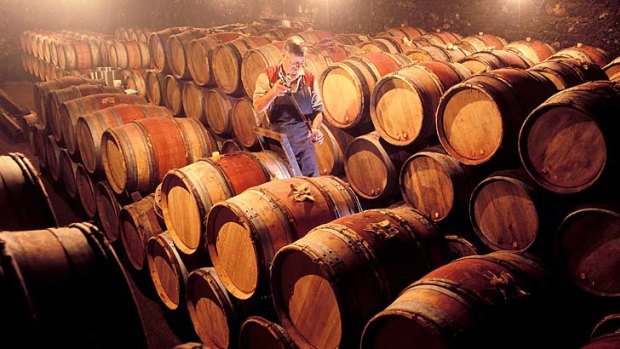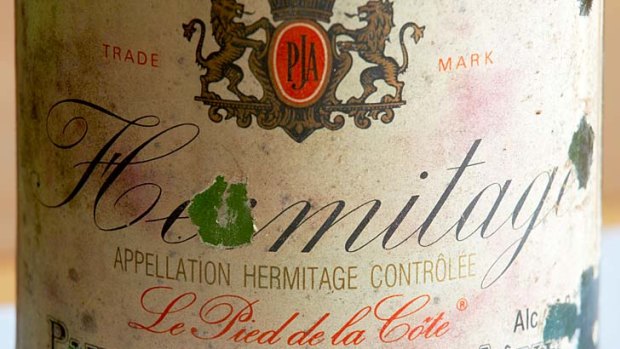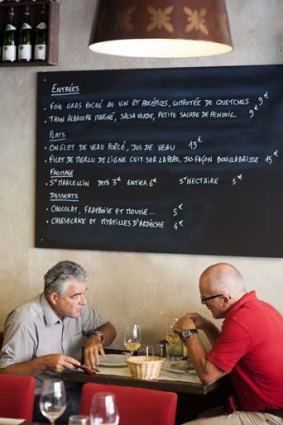
By the barrel... taking samples for tasting at Tain l'Hermitage.Credit: Alamy
Leisa Tyler visits the Rhone Valley home of Louis XIII’s favourite wines and finds a smart dining scene to match.
In the 13th century, Gaspard de Sterimberg returned from the Albigensian Crusade and settled in the Rhone. The knight was badly wounded in the war being waged by the Church against Catharism – a movement that didn’t recognise the authority of the Pope – and sought to live out his days as a hermit.
Sterimberg traversed the hills of the northern Rhone Valley, at that time peppered with mediaeval villages amid thick swathes of forest, before discovering the perfect place for a retreat: a rocky hill commanding glorious views over the ranges of nearby provinces and the Rhone River as it snaked past the Roman-era hamlet of Tain into a vast, flat, fertile vale.

Tain l'Hermitage wine.Credit: Alamy
He built a stone chapel and dedicated it to Saint Christopher, and on the loosely packed granite slopes tumbling to the river, planted grapes. Known as syrah, the grapes produced a bold, ruby-red wine with a long, robust palate.
Where Sterimberg obtained his cuttings has been a source of considerable speculation: Shiraz, Persia, was thought to have given syrah its other name (shiraz); Syracuse, in Sicily, was known to produce a similar wine at that time. Then there’s south-east France itself – recent scientific testing suggests syrah is a cross between the dureza and mondeuse blanche varietals grown there.
What is agreed is that the syrah from Sterimberg’s hill, called Hermitage in honour of the chapel, went on to make some of the Rhone Valley’s greatest and most sought-after wines. They were the drop of choice for King Louis XIII’s court (before an aphid known as phylloxera devastated Europe’s vines in the late 19th century, forcing France to import syrah vines from America).

Diners at Le Mangevins restaurant.Credit: Rama Knight
On a late summer’s afternoon I join staff from wine producer Maison Paul Jaboulet Aine at Sterimberg’s chapel. Barely two metres by two metres, the stone chapel has a small altar with statue of the Virgin Mary and several dusty wine glasses – left there, I’m told, by sommelier students for Sterimberg’s thirsty spirit.
There’s no doubting the noble knight’s taste in views. Spreading right and left, the Rhone Valley is drenched in a warm light. Below, the river snakes past Tain-l’Hermitage town. Stone buildings, some dating to Sterimberg’s day, are interspersed with church spires and poplars. Goblet vines, their thick trunks blackened and gnarled, surround us in every direction. It’s picking season and some vines have already been relieved of their sweet, plum-coloured fruit filled with an auburn-red juice. Others droop in tightly packed bunches, soaking up precious rays of sun.
Hermitage is one of the most prized appellations in the Rhone Valley. Several wineries have a stake in it, including Domaine Jean-Louis Chave, which dates to the 15th century, and Paul Jaboulet Aine, which bought the chapel in 1919 and produces La Chapelle, a coveted grand cru whose 1961 vintage was named by Wine Spectator Magazine as one of the 12 best wines of the 20th century.
It would be fitting to open a bottle of La Chapelle in Sterimberg’s honour but, at €15,000 ($19,460) a bottle, it’s not quite affordable. Instead, my hosts open a bottle of La Chapelle’s little sister, a 2008 Paul Jaboulet Aine La Petite Chapelle. It’s a stunning drop the winery started producing from the grapes of several Hermitage terroirs 10 years ago. Matching a smooth palate with lively tones of pepper, sweet spices and fresh wood, it’s almost as extraordinary as the view.
Wine isn’t Tain-l’Hermitage’s only asset. This town of about 6000 people is rarely recognised on tourist maps. But what it lacks in size it makes up for in gourmet ways. Premium chocolate maker Valrhona, which began business here in 1922, operates a sleek confectionery on a main street. The chocolate is expensive, but with big bowls of samplers to stuff yourself silly on and munificent staff who pop handfuls of freebies into your shopping bag at the check-out, it’s impossible not to make at least one trip a day.
Surrounded by farmland and forests for foraging, Tain-l’Hermitage and nearby villages are home to superb restaurants and bistros. Anne-Sophie Pic, who last year was awarded UK Restaurant Magazine’s Best Female Chef in the World’s 50 Best Restaurants, has an eponymous restaurant housed in a stone courtyard in Valence, a 30-minute drive south of Tain-l’Hermitage. At €330 a person, plus taxes, she doesn’t serve an everyday meal. More laissez-faire is Pic’s bistro next door, Le 7, where dishes of cucumber gazpacho with green anise, pate with quince poached in red wine and a three-course meal cost about €40 a person.
I also dine at Valence’s Quai Ouest, a small canal-side cafe with outdoor tables scattered under shady trees where simple but excellent dishes such as penne with aubergine, artichoke, ham and ricotta, and generously sized salads of local seasonal vegetables with smoked salmon cost about €12 a dish. Le Bistrot des Clercs, in Valence’s old city, is known for having hosted Napoleon Bonaparte at its tables. At night the restaurant’s Parisian-style courtyard comes alive with the trickle of a water fountain (built in Napoleon’s honour), the clink of glasses and guests enjoying grilled lobster, fish with capers and cream and decadently fatty pig’s trotters.
But the restaurant that steals my heart is Le Mangevins, a six-table hole-in-the-wall bistro run by Vincent Dallat and his Japanese chef-wife, Keiko. Their daily menu of just two entrees, two mains, two desserts and a few local cheeses is scribbled on a blackboard.
The dishes have just a handful of ingredients but all are extraordinarily good. My raw tuna in virgin olive oil with a salsa verde and fennel salad is so delectable I almost weep at the finish. The hake with vegetables and bouillabaisse sauce makes me wish I hadn’t eaten breakfast – or dinner the night before. I sop the juices with slices of perfectly baked sourdough and get giggly from drinking house wine, each bottle sourced from within a 20-kilometre radius – including, of course, the vines around Gaspard de Sterimberg’s chapel.
Leisa Tyler travelled courtesy of Paul Jaboulet Aine wines.
FAST FACTS
Getting there
Swiss International Airlines has a fare to Lyon from Sydney and Melbourne for about $2377 low-season return, including tax. Fly with a partner airline to Hong Kong (about 9hr), then to Zurich (13hr 11min) and then Lyons (1hr); see swiss.com. This fare allows you to fly via a number of Asian cities and from various European cities. Tain-l’Hermitage is a two-hour drive south of Lyon along the Autoroute du Soleil.
Staying there Hotel Les 2 Coteaux is a small, basic B&B with spotless rooms overlooking the Rhone River. Doubles from €62 ($80) a night; see www.hotel-les-2-coteaux-26.com.
Drinking and eating there
Vineum — Paul Jaboulet Aine’s cellar door stocks the entire Tain-l’Hermitage range. 25 Place du Taurobole, Tain-l’Hermitage; see jaboulet.com.
Valrhona Chocolat is on 14 Avenue du President-Roosevelt; see valrhona.com.
In Valence, Anne-Sophie Pic and Le 7 are at 285 Avenue Victor Hugo. See pic-valence.fr.
Quai Ouest is at 808 Boulevard General de Gaulle, Guilherand Granges. + 33 4 7543 1995.
Le Bistrot des Clercs is at 48 Grande Rue. +33 4 7555 5515.
Le Mangevins is at 6 Avenue du Docteur Paul Durand, Tain-l’Hermitage; +33 4 7507 7385.
More information
See ot.payshermitage.com.
Sign up for the Traveller Deals newsletter
Get exclusive travel deals delivered straight to your inbox. Sign up now.